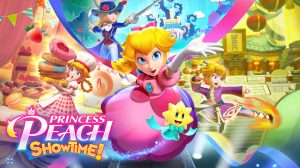Super Mario Bros. Wonder Review - Wonder By Name, Wonder By Nature
While the latest generation of 2D Mario platforms have been undoubtedly been excellent titles to play, they were lacking in identity. Nintendo’s DNA shone bright when it came to the platforming experience, however it lacked a visual flair, and a personality that made even the classic, far more visually primitive titles shine so brightly. As Nintendo continued to double down on the “New” Super Mario Bros. titles, the aesthetic further lost its lustre, and so fears existed that with the launch of the inevitable next chapter in the fabled 2D Mario franchise was going to be dampened by an increasingly less-appealing visual style, but all concerned citizens should rest easy, because not only are the visual stylings of Super Mario Bros. Wonder fantastically refreshing, but, more importantly, the game is sublime.
Bowser has had a penchant for taking over castles over the years, not to much success however. Perhaps it’s those decades of failures that prompted a well overdue change of tact, because now he’s decided to become the castle. Bowser has stolen the primary source of power in the Flower Kingdom, Wonder Power, and begins to wreak all kinds of havoc. Though a neighbouring kingdom, the legendary Mario finds himself on the case to put the Kooper King back in his place once again. Joined by Prince Florian, Mario sets out to rescue the denizens of the Flower Kingdom, thwarting Bowser’s hair-brained schemes in the process.
It’s a case of Wonder by name, wonder by nature, because everything in Super Mario Bros. Wonder elicits a sense of awe and wonder from the player, at the very least on the first encounter with something. There are a range of new mechanics introduced (more on those soon), but everything you’ve known about Mario platforms and the threats within has been flipped due to the new setting. Kooper Trooper’s in the Flower Kingdom behave differently to those of the Mushroom Kingdom, Piranha Plants too, and that’s all just where it begins. The Flower Kingdom subverts player expectations at every turn, and presents opportunities through platforming that we’ve not seen in a core 2D Mario platformer before.
Mechanically, things are different from the moment you go to boot up 1-1, with twelve (yes twelve) playable characters available to you. From staples like Mario, and Luigi, to Peach, Daisy, a range of Toad’s, and even four Yoshi variants and Nabbit, the five of whom have been made available for inexperienced players, allowing them to progress without taking damage. It was immediately obvious that Nintendo wanted to change things up, and they went even further in the playing experience itself. Super Mario Bros. Wonder adds badges, something akin to what Nintendo has delivered in titles like Paper Mario: Sticker Star for example, where Mario can equip a badge, and it will imbue him with a perk. From providing you with a Parachute cap, to allow you to glide to the surface more safely, to wall-climbing, and more immediate perks, like the ability to begin a level with a Super Mushroom power-up or additional coin rewards, Super Mario Bros. Wonder gives players further opportunities to make the game what they want it to be, whether that be easier, or more difficult, or even just to present new opportunities to reach the same goal. There are even expert badges that make the game much more challenging, for those looking to take some more risks in their gameplay. Prince Florian wears the badges, but the party gets all of the benefits.
Nintendo have added “Standees” for the benefit of online players. Standees are at face value, a bragging opportunity to say “I was here” but also, can rescue fellow players when engaged in online play. Strategic positioning of them could be extremely helpful to other players who get stuck and need a hand. It all feels very Death Stranding-like in that respect. There’s a bit of customisability to how you can use the Standees too which will keep things interesting for players looking to collaborate in a multitude of ways. The multiplayer itself is rooted in what players enjoyed from multiplayer in the last few 2D Mario platformers, but a few quality of life additions have been made (including the standees) to make the experience more accessible and consistently enjoyable than ever before. You can’t toss teammates anymore, much to the delight of everyone who will ever play with me, while death isn’t instant, and can be prevented. For players of every side of the experience spectrum, you’ll have the systems available to you to thrive.



Of course, the core pillar of any 2D Mario game is of course the base platforming, and I was surprised to see that Nintendo has jacked the difficulty up a bit from recent 2D Mario entries. Obviously the use of certain badges will have a bearing on all of this, but even the base level design is more challenging than much of what we’ve seen over the last couple of decades. Finding Wonder Flowers within the level change things up further (literally), with the world springing to life in weird and wonderful ways. You’ll be dodging obstacles, running atop crawling pipes, and a bunch more, some of which is more visually stimulating than it is challenging, while others really want to test the players’ mettle.
While the marketing focus has been on the newly added Elephant power-up, players should also be noting a range of other additions including the drill hat and bubble flower which provide new ways to play the game. Some aspects of these new suits feel somewhat derivative of other Mario entries, but they’re still delivered in such an endearing way that you’ll not find yourself caring, and will be just excited to don the Elephant suit once again.
Earlier I discussed the visual style of prior entries and how flavourless it felt – that is not the case in Super Mario Bros Wonder. While much of the DNA from the “New” games is present, there’s also been some DNA splicing take place to give Wonder a familiar, but incredibly fresh feel about it. Edges feel smoother, colours are more vibrant, and characters (both visually, but also via increased amounts of voice acting) are much more expressive. While the new voice of Mario is a little jarring at first, the road Charles Martinet has paved is being trodden on with great respect, and the new voice is bound to feel natural before we all know it. Meanwhile the soundtrack is just what you expect from a Mario game, quirky, but in possession of a level of charm that will win over even the most cynical of players.
Super Mario Bros. Wonder is the 2D Mario game that we’ve all been awaiting. It’s more of what you know, layered with new elements that force you to rethink the way you’ve played a Mario game up til this point. With clever challenges and customisable challenges all available, a wonderful new art style, top-tier plaforming mechanics, systems that are additive to the experience, and more, Super Mario Bros. Wonder is simply, not to be missed.

Super Mario Bros. Wonder was reviewed on a Nintendo Switch with code kindly provided by Nintendo Australia










